Click image for BBB rating
See our Privacy Policy
cool="cool" width="786" height="7169" border="0" cellpadding="0" cellspacing="0" gridx="16" showgridx="showgridx" usegridx="usegridx" gridy="16" showgridy="showgridy" usegridy="usegridy" bgcolor="#99ccff">
|
|
|
|
|
|
|
|
|
Spaightwood Galleries
Masters of Modernity: Nature II: Chagall / Giacometti
|
|
|
|
|
|
For Chagall, humans and nature share a setting and are boith amphibious creatures: animals have human characterists; humans have animal characteristics. This may be related to his interest in La Fontaines Fables or in Russian folk tales; it may be that as fabulist himself, he did not care for rigid distinctions between the natural wold and the human or find them useful. Unlike Braque and Miró who used birds consistently and importantly in their works, Chagall appears to have been less interested in birds than in flowers, which appear everywhere in his works. Giacometti, on the other hand, seems little interested in nature with the exception of cats, dogs, and trees, one of which we present below, in what may be his only color lithograph.
|
|
|
|
|
|
|
|
|
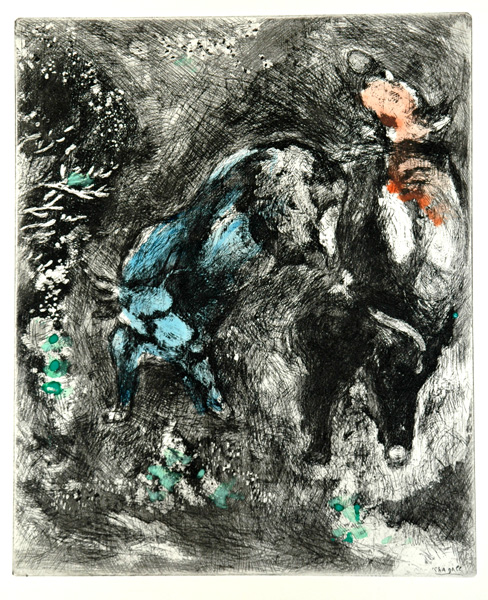 |
|
Marc Chagall (Russia 1887-1985 Paris), Les deux Taureaux et une Grenouille / The two bulls and a frog (H. 160, S. 106). Original etching with hand coloring by Chagall, 1927-30. Plate 14 of The Fables of La Fontaine, commissioned by Vollard after Chagall completed the etchings for Dead Souls. 100 pencil signed impressions, 85 impressions hand-colored by Chagall (of which ours is one), and 240 impressions (of which 40 are on japon paper) signed in the plate for The Fables of La Fontaine. Two bulls contend for the rule of a herd ("and a heifer within the herd." A frog, sighing is asked by another why he sighs. The frog replies that the loser, "banned from his estate— / Those magnificent flower-dotted meadows we see— / And maim us with clumsy feet however deep we go." In the event the frog is right: "One of the bulls retired to the shore / Where the frogs were mangled by his weight / As hourly he trod on twenty or more." The moral? "From the first it has been so—how unfortunate! / The weak must suffer for the follies of the great" (Marianne Moore, trans.). Image size: 296x241mm. Price: Please call or email for current pricing information.
|
|
|
|
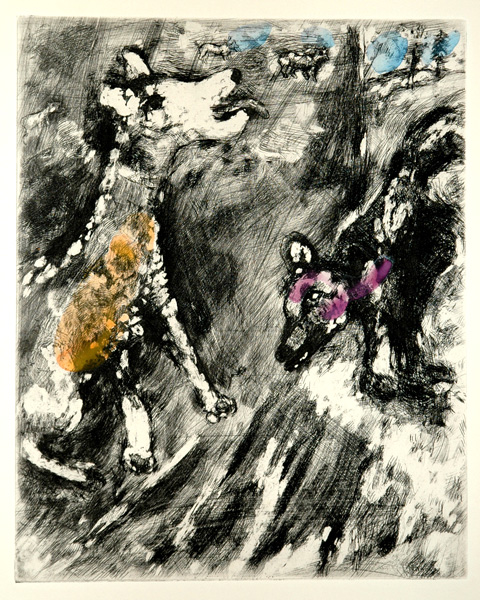 |
|
Marc Chagall (Russia 1887-1985 Paris), La Lice et sa Compagne / The bitch and her Friend (H. 162, S. 109). Original etching with hand coloring by Chagall, 1927-30. Plate 16 of The Fables of La Fontaine, commissioned by Vollard after Chagall completed the etchings for Dead Souls. 100 pencil signed impressions, 85 impressions hand-colored by Chagall, and 240 impressions (of which 40 are on japon paper) signed in the plate for The Fables of La Fontaine. A pregnant bitch begs a friend for the use of her leanto so that she can give birth to her litter. Afterwards, she refuses to leave, backed up by her very large offspring (visible at top). The moral: "One certainly rues aid to the malevolent. / If you'd recover what you lent, / A physical blow is all they feel. / You have to beg and then to beat. / Yield but a foot to their appeal / And find they have usurped four feet" (Marianne Moore, trans.). Image size: 298x237mm. Price: 6500.
|
|
|
|
|
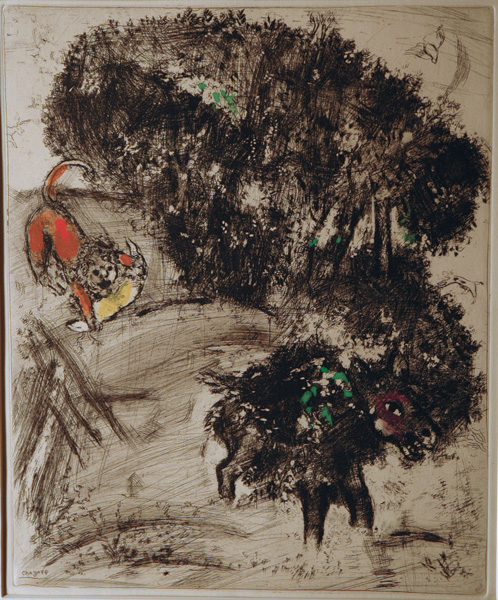 |
|
Marc Chagall (Russia 1887-1985 Paris), Lion et L'Ane Chassant (H. 192, S. 119). Original etching with hand coloring by Chagall, 1927-30. Plate 26 of The Fables of La Fontaine, commissioned by Vollard after Chagall completed the etchings for Dead Souls. 100 pencil signed impressions, 85 impressions hand-colored by Chagall, and 240 impressions (of which 40 are on japon paper) signed in the plate for The Fables of La Fontaine. A lion decides to go hunting to celebrate his birthday and hides an ass under a pile of leaves, instructing him to bray loudly in order to startle the other beasts. The ass does so, the beasts panic, the lion catches them and is pleased. The ass then tries to claim part of the credit for the success of the hunt. "The Lion said, 'You aided; I admit you brayed: / If I'd not known the source from which the sound arose / I might myself have been afraid.' " The ass "did not dare" to resent the lion's "slur": "For who would want an ass to boast of what he'd done? / It would not be in character" (Marianne Moore, trans.). Image size: 297x241mm. Price: Please call or email for current pricing information.
|
|
|
|
|
|
|
|
In De Mauvais Sujets, the narrative is a stream of consciousness within the mind of a young boy, worrying about appropriate subjects for his required essays in his French class at the same time that he is trying to find his own place within the Cartesian philosphical tradition (I think therefore I am) he is being taught and failing rather desperately: "La premiere fois, ç'a été vers l'age de dix ans, et ce n'était pas un découverte joyeuse, non. La voici: C'est que j'étais bête. Bête, ou, plus exactement vide: la pénsée ne me venait pas. Il s'agissait d'une panique, plus encore que d'une découverte, et je désespérais parfois de me corriger." (p. 9: The first time, it was about the age of 10 years old, and it was not a happy discovery, no! Here it is: I was a beast. A beast, or, more precisely empty: thought did not come to me. I panicked [i.e. fell into the state of total passionate existence in which Pan's followers dwell], all the more so for this discovery, and I despaired of ever correcting myself"). To take the place of reason, he tries to substitute the imagination: "Mois, j'étais jusque-là comme un enfant qui vient d'entendre ou d'imaginer quelque nouvelle dont il s'enchanté" (p. 40: Myself, I was until then like a child who has come to understand or to imagine something new with which he is completely enchanted) .
|
|
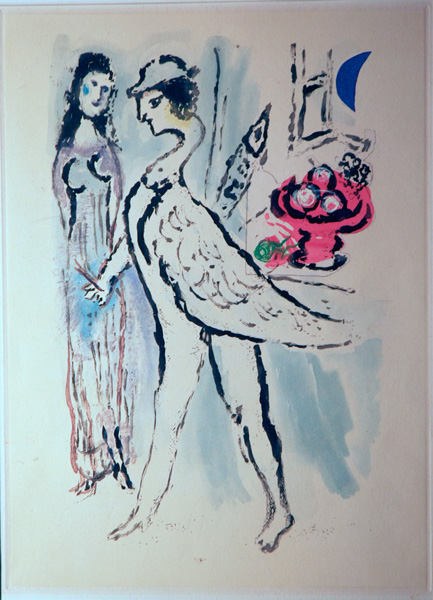 |
|
|
|
|
Marc Chagall (Russia 1887-1985 Paris), De Mauvais Sujets 4 (Cramer 35, Kornfeld 109, , Sorlier, p. 82). Original color etching, 1958. 134 unsigned impressions on Arches plus 19 signed and numbered 1/9 to 9/9 and A/J to J/J on Japon Nacré), all of which have the blindstamp of the book club, BUF. Full page illustration in Sorlier. Image size: 369x271mm. Price: Please call or email for current pricing information.
|
|
|
|
|
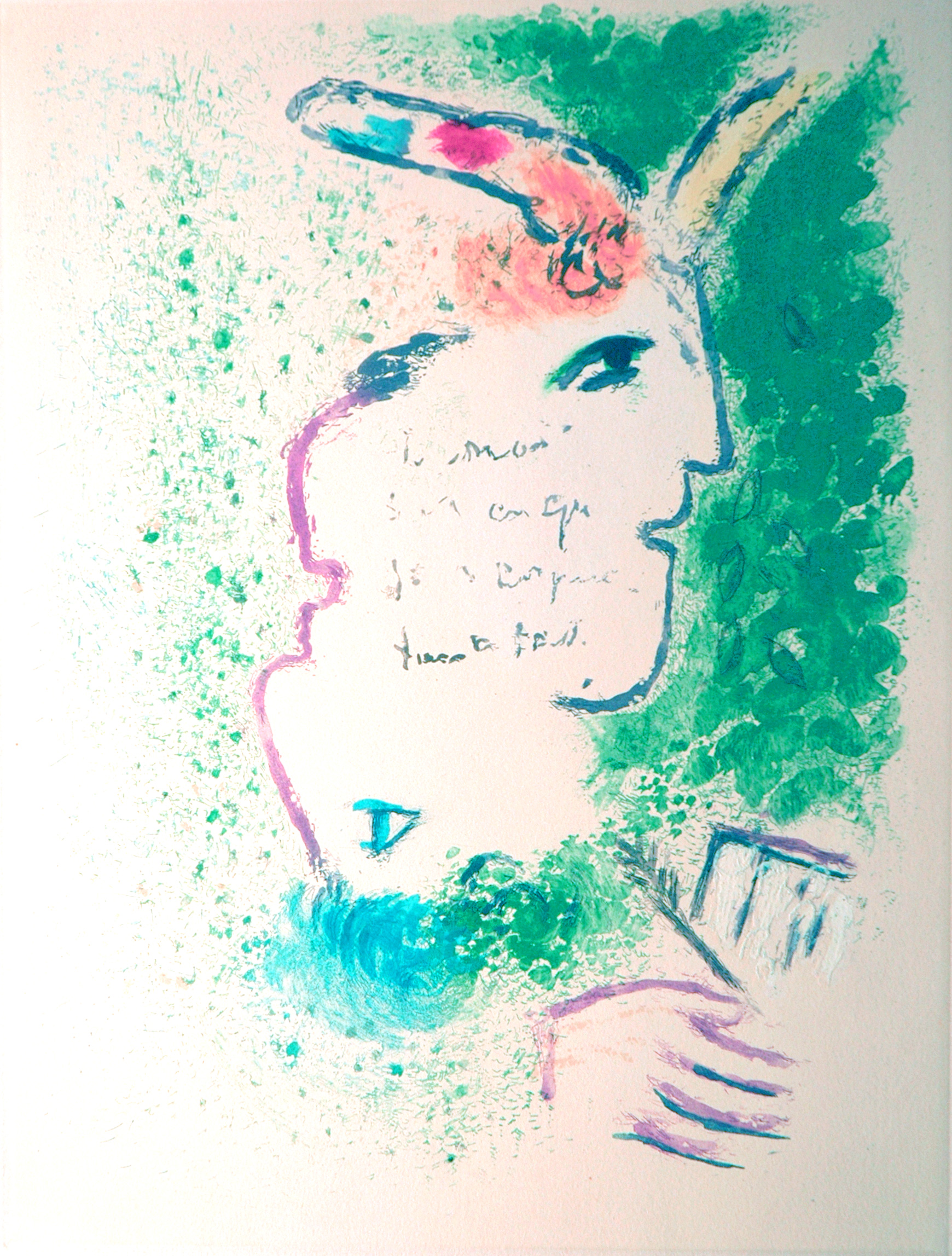 |
|
Marc Chagall (Russia 1887-1985 Paris), De Mauvais Sujets 5 (Cramer 35, Kornfeld 110, Sorlier, p. 82). Original color etching, 1958. 134 unsigned impressions on Arches plus 19 signed and numbered 1/9 to 9/9 and A/J to J/J on Japon Nacré), all of which have the blindstamp of the book club, BUF. Image size: 349x267mm. Price: Please call or email for current pricing information.
|
|
|
|
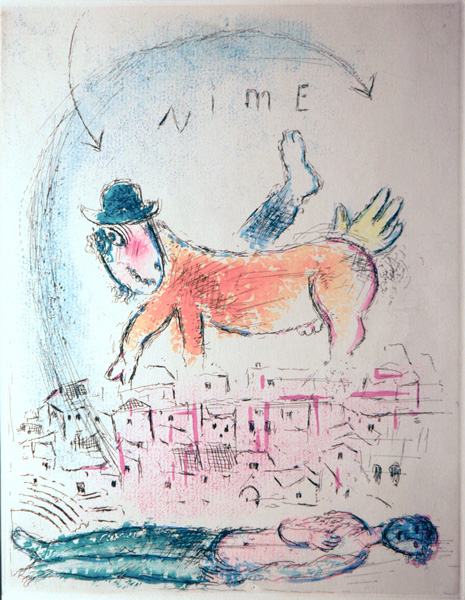 |
|
Marc Chagall (Russia 1887-1985 Paris), De Mauvais Sujets 7 (Cramer 35, Kornfeld 112, Sorlier, p. 82). Original color etching, 1958. 134 unsigned impressions on Arches plus 19 signed and numbered 1/9 to 9/9 and A/J to J/J on Japon Nacré), all of which have the blindstamp of the book club, BUF. Image size: 346x273mm. Price: Please call or email for current pricing information.
|
|
|
|
|
|
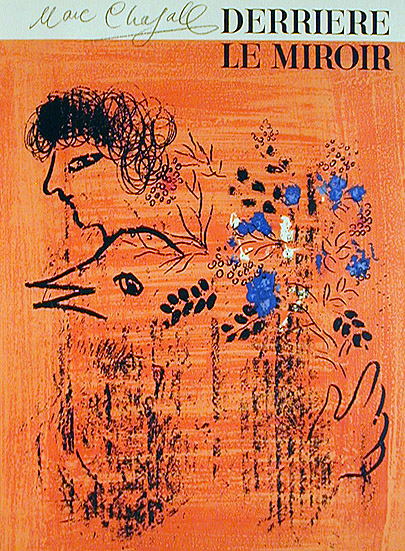 |
|
Marc Chagall (Russia 1887-1985 Paris), Bouquet a l'oiseau (M. 298). Original color lithograph, 1960. Edition: 75 signed & numbered impressions plus c. 2000 unsigned impressions for the deluxe French art review, Derrière le Miroir. Ours is an impression with a complimentary signature. A brilliant impression of one of Chagall's most beautiful early images. Illustrated Nice 1987. Image size: 340x260mm. Price: Please call or email for current pricing information.
An unsigned impression of the Derrière le Miroir impressions matted so that the lettering at top is not visible is also available for Please call or email for current pricing information.
|
|
|
|
|
|
|
|
From the prominent role that flowers play in so many of Chagall's paintings and lithographs, it is clear that they meant something important to him. Flowers feature prominently in works dealing with lovers, whether in their first inital reachings-out to each other or in the continuing beauty of their love; sometimes, in light of the sad expressions on the faces of one or the other of the lovers, they may also suggest the short lifespan of beautiful things (possibly in recognition of the sudden death of Chagall's beloved first wife, Bella, possibly in their traditional meaning in Dutch still lives of the Renaissance). If they are both beautiful and short-lived, however, they are also a symbol of the preciousness of the moment, of the need to seize that moment of love and hold on to it as fully as possible for as long as possible. But flowers are also often a symbol of new life, the return of beauty after the little death of winter and a sign of hope for a future blooming with new possibilities and fresh starts.
|
|
|
|
|
|
|
|
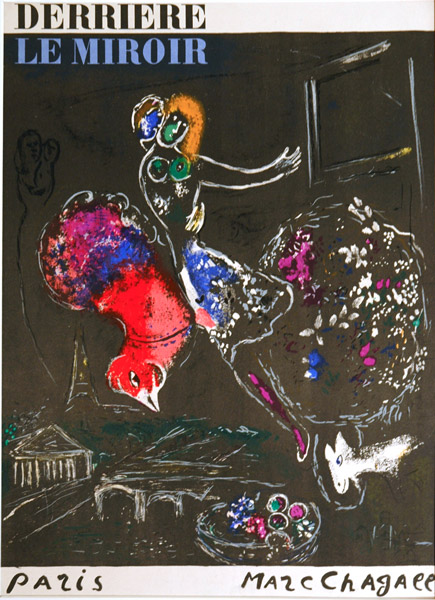 |
|
Marc Chagall (Russia 1887-1985 Paris), Night in Paris (M. 96). Original color lithograph, 1954. 75 signed & numbered + 2500 unsigned impressions. Published in a special issue of Derrière le Miroir dedicated to Chagall's vision of Paris. Illustrated Marc Chagall: Bonjour Paris and Nice 1987. These lithographs are remarkable for the extraordinary intensity of their colors. Image size: 335x280mm. Price: Please call or email for current pricing information.
|
|
|
|
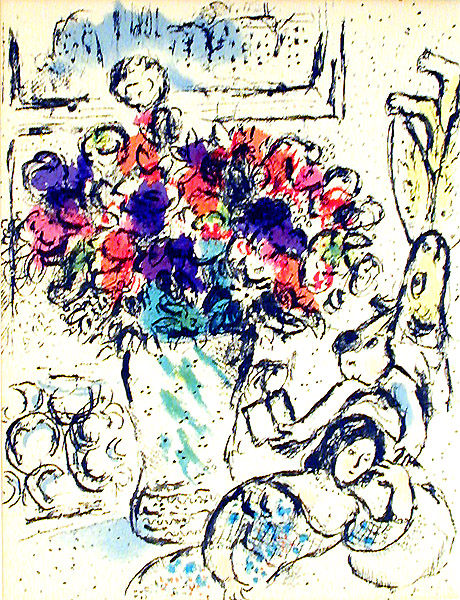 |
|
Marc Chagall (Russia 1887-1985 Paris), The anemones (M. 730). Original color lithograph, 1974. 50 signed & numbered impressions + 10,000 impressions for Chagall Lithographe IV. Image size: 325x250mm. Price: Please call or email for current pricing information.
|
|
|
|
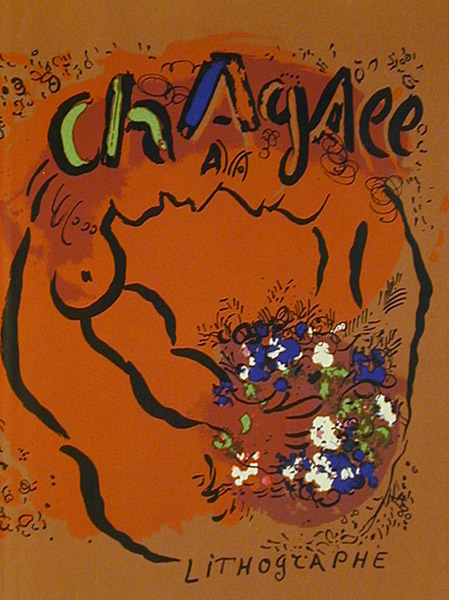 |
|
Marc Chagall (Russia 1887-1985 Paris), Lovers with bouquet (M. 281a). Original color lithograph, 1960. 100 numbered impressions + c. 2000 unsigned impressions for Chagall Lithographe I. There were also 40 signed and numbered impressions reserved for the artist. Image size: 325x250mm. Price: Please call or email for current pricing information.
|
|
|
|
|
|
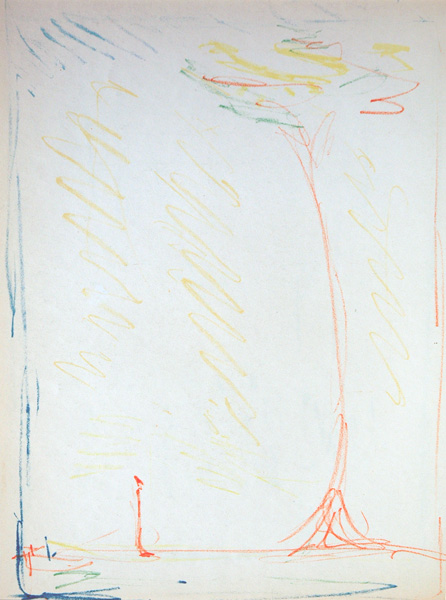 |
|
Alberto Giacometti (Swiss, 1901-1966), The Tree. Original color lithograph, 1952. As published in the 1952 issue of the deluxe art review Verve. Giacometti's original lithograph, City Scene, is printed on the reverse (see here). A very vertical person contemplates the even-more pronounced verticality of the tree. This may be Giacometti's only color lithograph; it is certainly one of a very small number if there are others. Included in the 2007 Giacometti retrospective at the Pompidou Center, Paris. Image size: 353x232mm. Price: Please call or email for current pricing information.
|
|
|
|
|
|
Spaightwood Galleries, Inc.
To purchase, call us at 1-800-809-3343 (1-508-529-2511 in Upton MA & vicinity) or send an email to spaightwood@gmail.com. We accept AmericanExpress, DiscoverCard, MasterCard, and Visa.
For directions and visiting information, please call. We are, of course, always available over the web and by telephone (see above for contact information). Click the following for links to past shows and artists. For a visual tour of the gallery, please click here. For information about Andy Weiner and Sonja Hansard-Weiner, please click here. For a list of special offers currently available, see Specials.
Visiting hours: Saturday 10:00 am to 5:00 pm and Sunday noon to 6:00 pm and other times by arrangement. Please call to confirm your visit. Browsers and guests are welcome.
|
|
|
|
|
|
|
|
|
|
|
|
|
|
|
|
|
|
|
|
|
|
|
|
|
|
|
|
|
|
|
|
|
|
|
|
|
|
|
|
|
|










